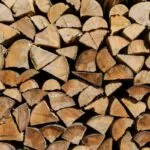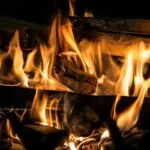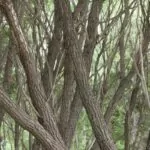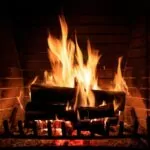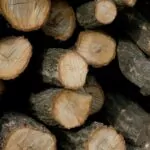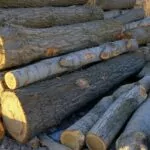Choosing the right type of wood can significantly improve efficiency, safety, and overall experience when using a fireplace.
Whether you’re using your fireplace for warmth, ambiance, or cooking, using the correct type of wood is essential to ensure a clean, efficient burn.
Not only is it important to choose the right type of wood, but it’s also essential to make sure the wood you’re using is seasoned.
Seasoned wood has been dried to a low moisture content. This helps prevent the build-up of creosote in your chimney, reduces the amount of smoke produced, and increases the heat output.
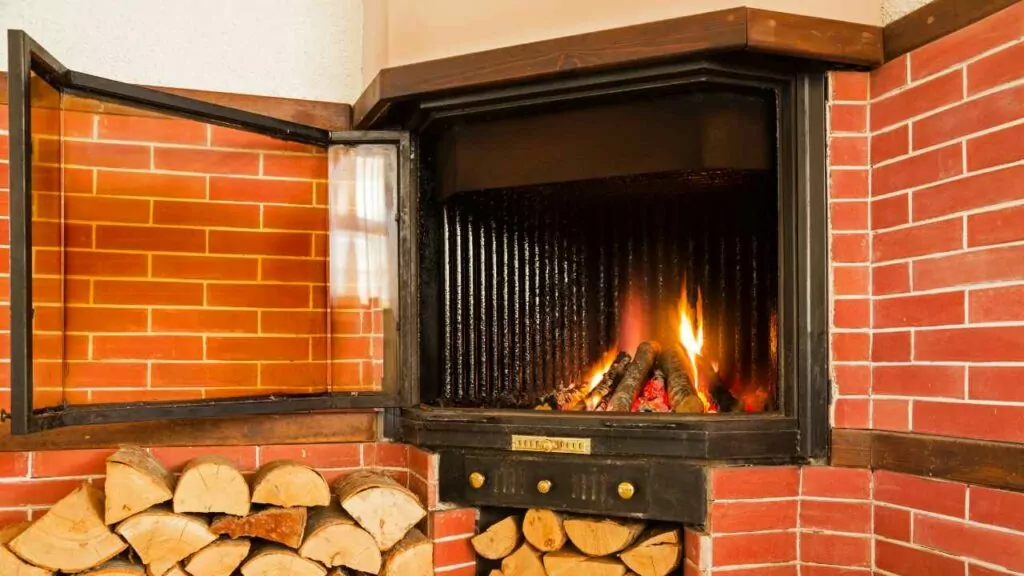
It’s also important to consider the environmental impact of burning wood.
Although wood is a renewable resource, burning wood produces carbon emissions, contributes to air pollution, and can lead to deforestation if not appropriately managed. For these reasons, it’s essential to choose sustainable wood from sustainable sources and use it efficiently.
With so many types of wood available, it cannot be easy to know which is best for your fireplace.
To help you make an informed decision, we’ve compiled a list of 50 popular types of wood. We have rated them based on their heating efficiency, sustainability, and overall suitability for a fireplace.
We have also compiled three helpful lists of the best, the worst, and the wood best suited for kindling.
Whether you’re a seasoned fireplace user or just getting started, this guide will help you find the right type of wood for your needs.
Factors to Consider When Choosing Firewood
Choosing the correct type of firewood can be a challenge, but by considering a few key factors, you can make the right choice for your needs. Some of the most important factors to consider when choosing firewood include the following:
Sustainability: Choosing firewood that comes from sustainable sources is essential, as this helps prevent deforestation and minimize the environmental impact of your fireplace.
Cost: The cost of firewood can vary widely depending on the type of wood and where you live, so it’s essential to consider your budget when deciding.
Hardness: Harder woods tend to burn longer and produce more heat than softer woods, but they can also be more difficult to split and can produce more creosote.
Resin content: Some woods contain a high amount of resin, which can cause the wood to burn too hot and produce a lot of smoke. These woods are not recommended for use in a fireplace.
Availability: The availability of firewood can vary depending on where you live, so it’s crucial to choose a type of wood that is readily available in your area.
Suitability for fireplace: Some woods are more suitable for use in a fireplace than others based on their heating efficiency, smoke production, and creosote build-up.
Considering these factors, you can make an informed decision and choose the right type of firewood for your needs.
When using your fireplace for warmth, ambiance, or cooking, it is vital to use the correct type of wood. This will ensure a clean, efficient burn and maximize the benefits of your fireplace.
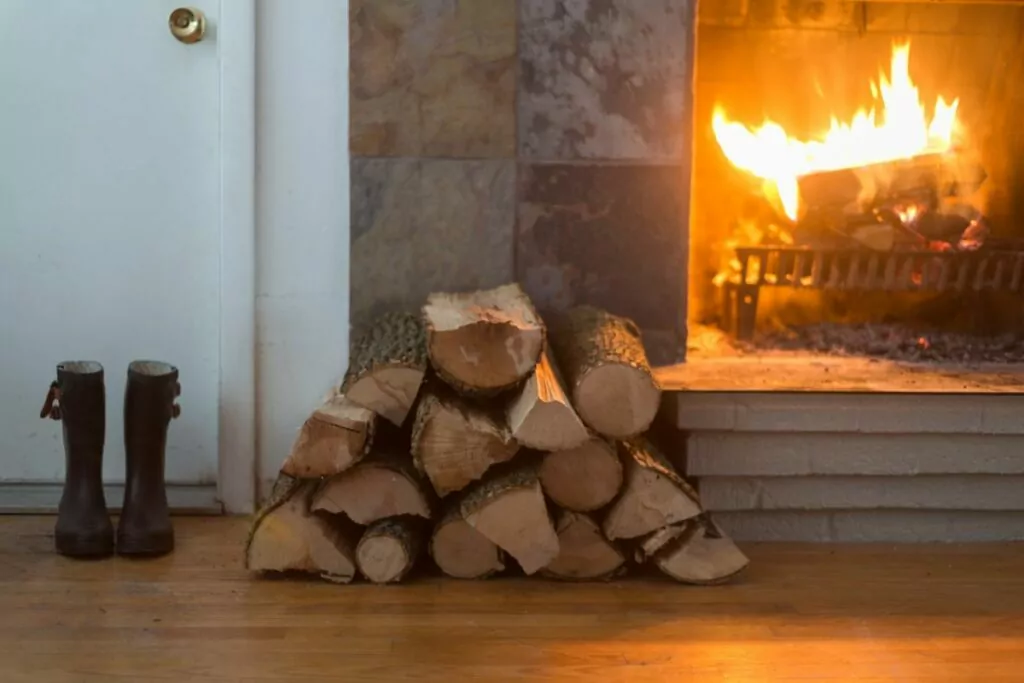
Top 10 Firewood Choices
Oak
Oak is a hard and dense wood widely available and highly prized for its heating efficiency. Oak burns slowly and produces a lot of heat, making it an excellent choice for keeping your home warm. Oak is also relatively low in resin content, which helps to minimize smoke production and creosote build-up.
Oak is relatively expensive compared to some other types of firewood. Still, its high quality makes it an excellent choice for those willing to spend a little extra. The aroma produced by oak is often described as rich and smoky.
Maple
Maple is another widely available hardwood and is highly prized for its heating efficiency. Maple burns slowly and produces a lot of heat, making it an excellent choice for keeping your home warm. Maple is relatively low in resin content, which helps to minimize smoke production and creosote build-up.
Maple is generally more affordable than oak, making it a good choice for those on a budget. The aroma produced by maple is often described as sweet and slightly nutty.
Cherry
Cherry is a medium-hard wood that is widely available and highly prized for its attractive color and distinctive aroma. Cherry burns slowly and produces a lot of heat, making it a great choice for keeping your home warm.
Cherry is relatively low in resin content, which helps to minimize smoke production and creosote build-up. The aroma of cherry wood is often described as sweet and fruity, making it an excellent choice for those who want to add a touch of elegance to their fireplace.
Apple
Apple is a medium-hard wood that is widely available and highly prized for its attractive color and distinctive aroma. Apple burns slowly and produces a lot of heat, making it a great choice for keeping your home warm.
Apple is relatively low in resin content, which helps to minimize smoke production and creosote build-up. The aroma of apple wood is often described as sweet and fruity, making it a great choice for those who want to add a touch of elegance to their fireplace.
Birch
Birch is a medium-hard wood widely available and highly prized for its attractive color and distinctive aroma. Birch burns slowly and produces a lot of heat, making it a great choice for keeping your home warm.
Birch is relatively low in resin content, which helps to minimize smoke production and creosote build-up. The aroma of birch is often described as slightly sweet and smoky, making it a great choice for those who want to add a touch of elegance to their fireplace.
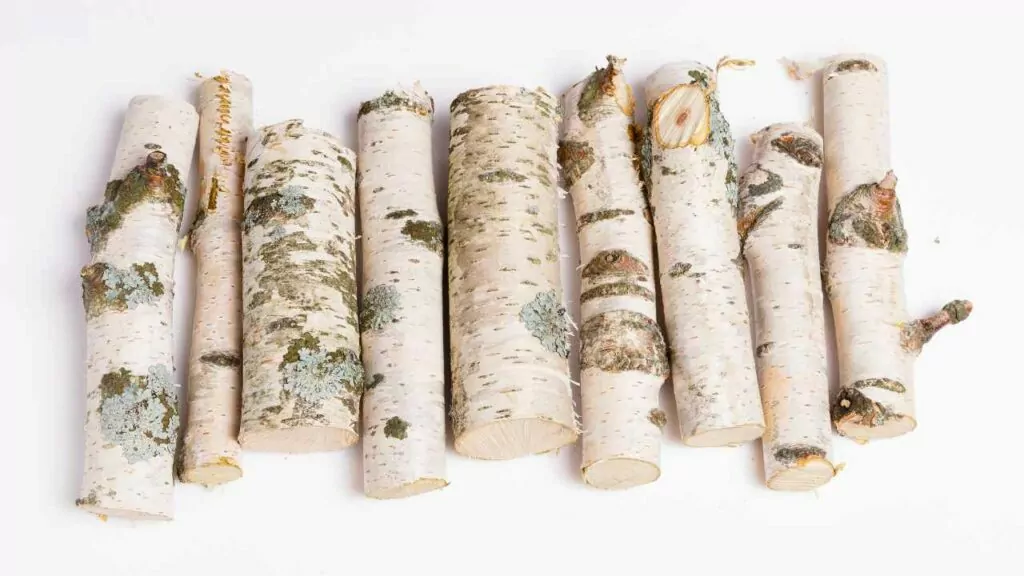
Hickory
Hickory is a hardwood widely available and highly prized for its heating efficiency. Hickory burns slowly and produces a lot of heat, making it an excellent choice for keeping your home warm. Hickory is relatively low in resin content, which helps to minimize smoke production and creosote build-up.
The aroma produced by hickory is often described as smoky and slightly sweet, making it a great choice for those who want to add a smoky flavor to their fireplace.
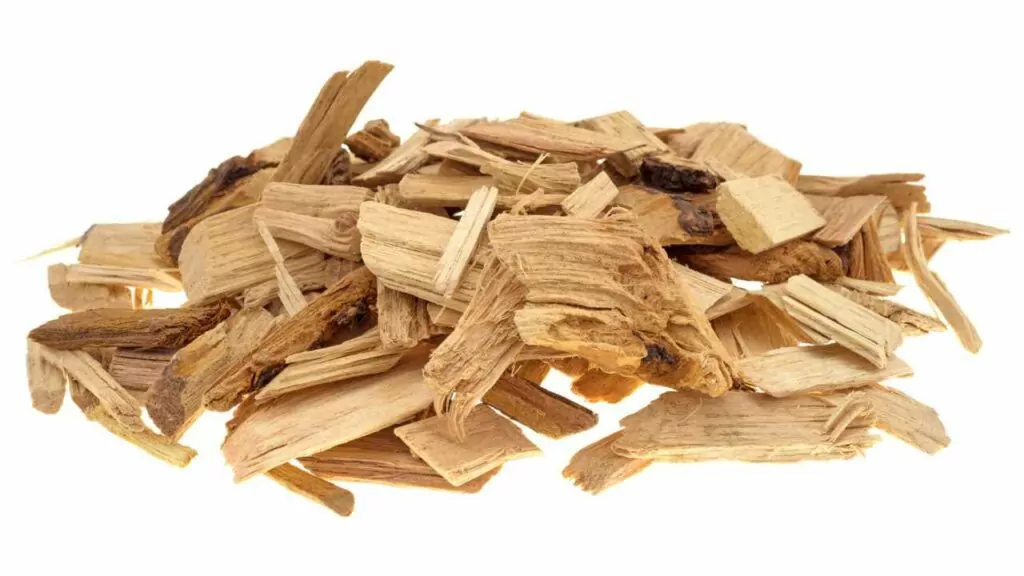
Red Oak
Red Oak is a widely available hardwood and is highly prized for its heating efficiency and attractive color. Red Oak burns slowly and produces a lot of heat, making it a great choice for keeping your home warm. Red Oak is relatively low in resin content, which helps to minimize smoke production and creosote build-up.
The aroma produced by Red Oak is often described as being rich and slightly smoky. Making it an excellent choice for those who want to add a touch of elegance to their fireplace.
Ash
Ash is a widely available hardwood and is highly prized for its heating efficiency. Ash burns quickly and produces a lot of heat, making it a great choice for those who want the most heat from their firewood.
Ash is relatively low in resin content, which helps to minimize smoke production and creosote build-up. The aroma produced by ash is often described as being slightly smoky and slightly sweet.
Poplar
Poplar is a widely available softwood and is highly prized for its heating efficiency. Poplar burns quickly and produces a lot of heat, making it a great choice for those who want the most heat from their firewood.
Poplar is relatively low in resin content, which helps to minimize smoke production and creosote build-up. Poplar is generally more affordable than the other types of firewood on this list, making it a good choice for those on a budget. The aroma produced by poplar is often described as mild and slightly sweet.
Sweet Chestnut
Sweet Chestnut is a hardwood that is widely available and highly prized for its heating efficiency and attractive color. Sweet Chestnut burns slowly and produces a lot of heat, making it an excellent choice for keeping your home warm.
Sweet Chestnut is relatively low in resin content, which helps to minimize smoke production and creosote build-up. The aroma produced by Sweet Chestnut is often described as being nutty and slightly sweet. Making it a great choice for those who want to add a touch of natural flavor to their fireplace.
These are the top 10 firewood choices based on sustainability, cost, hardness, resin content, availability, and suitability for burning in a fireplace.
Choosing the right wood can help ensure a clean, efficient burn and maximize the benefits of your fireplace.
Top 10 Worst Firewood Choices
Pine
Pine is a softwood that is not ideal for a fireplace as it burns quickly and produces minimal heat.
Additionally, pine releases a lot of smoke and creosote, which can clog chimneys and pose a fire hazard. The smoke from burning pine also has a strong, resinous odor that many people find unpleasant.
Cedar
Cedar is another softwood that is not recommended for use in a fireplace. Cedar burns quickly and produces low heat, making it less efficient than other types of firewood.
Cedar also releases a significant amount of smoke and creosote, which can clog chimneys and pose a fire hazard.
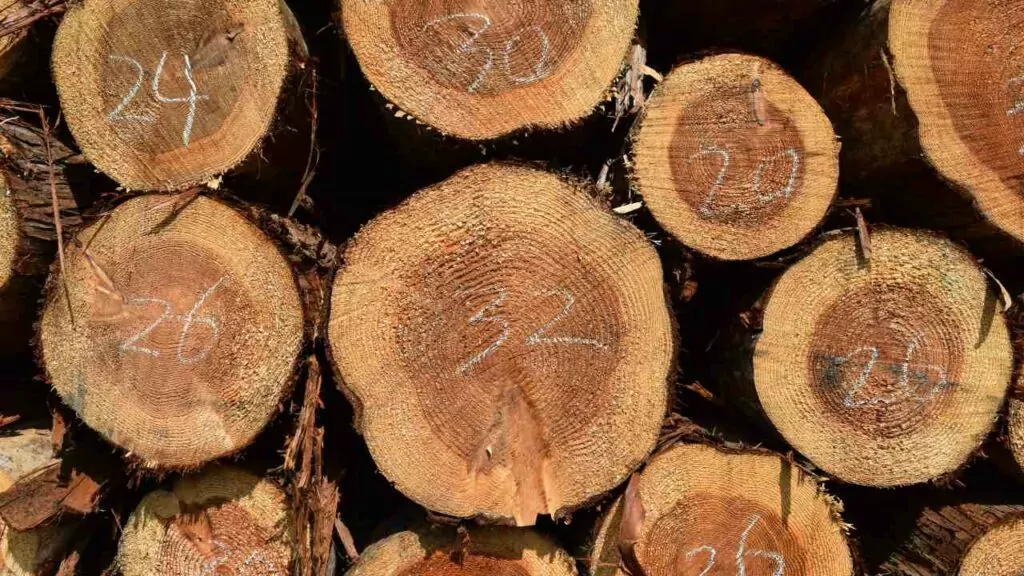
Lime
Lime is another softwood that is not a good choice for use in a fireplace. Lime burns quickly and produces very little heat, making it a less efficient source of warmth.
Lime also releases a large amount of smoke, which can clog chimneys and pollute the air.
Hawthorn
Hawthorn is a hardwood that is not ideal for use in a fireplace. Although it burns more slowly than softwoods, hawthorn still produces low heat and a significant amount of smoke and creosote.
These factors can clog chimneys and pose a fire hazard.
Elm
Elm is a hardwood not recommended for use in a fireplace due to its high moisture content and tendency to rot. This means that elm produces a lot of smoke and creosote when burned, which can clog chimneys and pose a fire hazard.
Also, elm burns inefficiently, leaving unburned residue and producing low heat output.
Sweetgum
Sweetgum is a hardwood not recommended for use in a fireplace. Sweetgum burns quickly and produces low heat, making it less efficient than other types of firewood.
Sweetgum also releases a significant amount of smoke and creosote, which can clog chimneys and pose a fire hazard.
Flowering Dogwood
Flowering dogwood is a hardwood that is not ideal for use in a fireplace. Although it burns more slowly than some softwoods, flowering dogwood still produces low heat and a significant amount of smoke and creosote.
These factors can clog chimneys and pose a fire hazard.
Blackthorne
Blackthorn is a hardwood that is not recommended for use in a fireplace. Blackthorn burns slowly and produces low heat, making it less efficient than other types of firewood.
Blackthorn also releases a significant amount of smoke and creosote, which can clog chimneys and pose a fire hazard.
Holly
Holly is a hardwood that is not ideal for use in a fireplace. Holly burns slowly and produces low heat, making it less efficient than other types of firewood.
Holly also releases a significant amount of smoke and creosote, which can clog chimneys and pose a fire hazard.
Horse Chestnut
Horse chestnut is a hardwood not recommended in a fireplace. Horse chestnut burns slowly and produces low heat, making it less efficient than other types of firewood.
Horse chestnut also releases a significant amount of smoke and creosote, which can clog chimneys and pose a fire hazard.
Best 10 Wood Used For Kindling
Kindling is commonly made from small pieces of wood, paper, or cardboard and is utilized along with fire starters to ignite a fire. We recommend using these small pieces of wood kindling to build your fire.
Birch
Birch is one of the best woods for kindling due to its high resin content, which makes it easy to ignite. Birch also burns hot and fast, providing a quick and efficient way to start your fire.
Birch is widely available, especially in northern regions of North America and Europe. It is relatively inexpensive, making it a popular choice for kindling.
Cedar
Cedar is another excellent choice for kindling due to its high resin content and light, fibrous texture. Cedar ignites easily and burns hot, making it a perfect choice for starting a fire.
Cedar is widely available, especially in regions where it grows naturally, such as the western coast of North America. It is relatively inexpensive, making it a popular choice for kindling.
Fatwood
Fatwood, also known as pine knots, is made from the heartwood of pine trees and is rich in resin. Fatwood ignites easily and burns hot, making it an excellent choice for kindling. Fatwood is often harvested from stumps and dead trees, making it a sustainable option for kindling.
Fatwood can be more expensive than other types of kindling, but it is worth it for its high quality and ease of use. Fatwood is most commonly found in southern regions of North America, where pine trees are abundant.
Douglas Fir
Douglas fir is a softwood well-suited for kindling use. Douglas fir is light and fibrous, making it easy to ignite, and burns hot and fast, providing a quick and efficient way to start your fire.
Douglas fir is widely available, especially in regions where it grows naturally, such as the western coast of North America. It is relatively inexpensive, making it a popular choice for kindling.
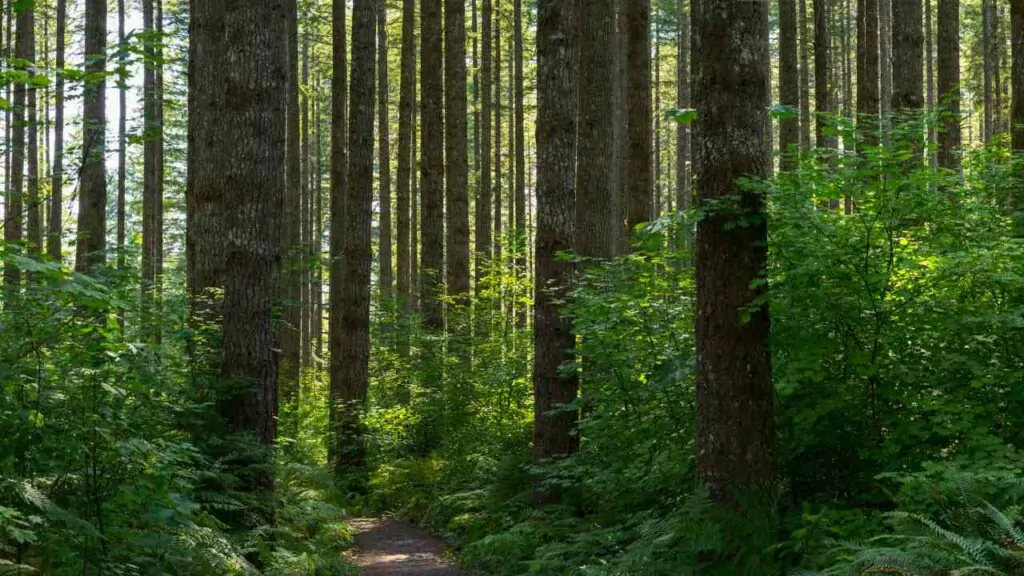
Spruce
Spruce is another softwood that is well-suited for use as kindling. Spruce is light and fibrous, making it easy to ignite, and it burns hot and fast, providing a quick and efficient way to start your fire.
Spruce is widely available, especially in northern North America and Europe, where it grows naturally. It is relatively inexpensive, making it a popular choice for kindling.
Jack Pine
Jack pine is a softwood well-suited for kindling use. Jack pine is light and fibrous, making it easy to ignite, and burns hot and fast, providing a quick and efficient way to start your fire.
Jack pine is widely available, especially in northern North America, where it grows naturally. It is relatively inexpensive, making it a popular choice for kindling.
Redwood
Redwood is a softwood that is well-suited for use as kindling. Redwood is light and fibrous, making it easy to ignite, and burns hot and fast, providing a quick and efficient way to start your fire.
Redwood is widely available, especially in regions where it grows naturally, such as the western coast of North America. It is relatively inexpensive, making it a popular choice for kindling.
Tamarack
Tamarack is a softwood that is well-suited for use as kindling. Tamarack is light and fibrous, making it easy to ignite, and burns hot and fast, providing a quick and efficient way to start your fire. Tamarack is widely available, especially in northern regions of North America, where it grows naturally and is relatively inexpensive, making it a popular choice for kindling and easy to ignite.
It burns hot and fast, providing a quick and efficient way to start your fire. Lodgepole pine is widely available, especially in western regions of North America, where it grows naturally. It is relatively inexpensive, making it a popular choice for kindling.
Lodgepole Pine
Lodgepole pine is a softwood that is well-suited for use as kindling. Lodgepole pine is light and fibrous, making it easy to ignite, and burns hot and fast, providing a quick and efficient way to start your fire.
Lodgepole pine is widely available, especially in western regions of North America, where it grows naturally. It is relatively inexpensive, making it a popular choice for kindling.
Eastern White Pine
Eastern white pine is a softwood that is well-suited for use as kindling. Eastern white pine is light and fibrous, making it easy to ignite, and burns hot and fast, providing a quick and efficient way to start your fire. Eastern white pine is widely available, especially in eastern regions of North America, where it grows naturally.
It is relatively inexpensive, making it a popular choice for kindling. Additionally, eastern white pine has a pleasant, fresh aroma when burned, making it a popular choice for kindling among those who value the sensory experience of a fire.
A Complete Guide to 50 Wood Varieties for Your Fireplace
Alder
Alder is a fast-growing wood species that is considered moderately sustainable. Although it is not as durable as other hardwoods, it regenerates quickly after being harvested, making it a good choice for those looking for a more sustainable option. Alder is also affordable, costing around $100 – $200 per cord.
When it comes to burning in a fireplace, Alder is a good choice. It burns well, produces a good amount of heat, and has a low to moderate resin content. However, its relatively low density means it burns more quickly than other hardwoods. Alder is well suited for smoking for fish and poultry due to its mild, sweet flavor. Alder is readily available in both North America and Europe.
Our Verdict:
- Fireplace: Good
- Smoking: Good
- Sustainability: Moderately Sustainable
- Availability: Readily Available
Apple
Apple is considered a moderately sustainable wood source, as it grows relatively quickly and is widely cultivated for its fruit. However, it is less durable than other hardwoods, so it may only last for a short time in outdoor applications. It is moderately priced, costing around $200 – $300 per cord.
Applewood is a good choice for burning in a fireplace. It burns well, produces a good amount of heat, and has a low resin content. However, its relatively low density means it burns more quickly than other hardwoods.
Applewood is also well suited for smoking, particularly for fish, poultry, and game birds, due to its mild, sweet flavor. Apple is readily available in both North America and Europe.
Our Verdict:
- Fireplace: Good
- Smoking: Good
- Sustainability: Moderately Sustainable
- Availability: Readily Available
Ash
Ash is considered a moderately sustainable wood source due to its fast growth and widespread cultivation of its wood. However, some ash species are susceptible to pests and diseases, so it may be less sustainable in some regions.
Ash is moderately priced, costing around $200 – $300 per cord. Ash is one of the best hardwoods for burning in a fireplace due to its high BTU output, low resin content, and good burning characteristics. It burns well and produces a good amount of heat.
Ash has a mild, neutral flavor, so it won’t impart much flavor to the food. It is readily available in both North America and Europe.
Our Verdict:
- Fireplace: Excellent
- Smoking: Neutral
- Sustainability: Moderately Sustainable
- Availability: Readily Available
Beech
Beech is considered to be a moderately sustainable wood source. It is a slow-growing species that takes a long time to regenerate after being harvested, but it is durable and long-lasting. Beech is moderately priced at around $200-$300 per cord. It is a hardwood with low to moderate resin content and is readily available.
Beech burns well and produces a good amount of heat. Still, its relatively low density means it burns relatively quickly compared to other hardwoods. Its mild, nutty flavor is considered neutral and won’t impart much flavor to the food. Beech is found in North America and Europe.
Our Verdict:
- Fireplace: Good
- Smoking: Neutral
- Availability: Readily Available
- Sustainability: Moderately Sustainable
Birch
Birch is considered to be a moderately sustainable wood source. It grows relatively quickly and is widely cultivated for its wood, but some species are susceptible to pests and diseases. Birch is moderately priced at around $200-$300 per cord. It is a hardwood with low to moderate resin content and is readily available.
Birch burns well and produces a good amount of heat. Still, its relatively low density means it burns relatively quickly compared to other hardwoods. Its mild, sweet flavor suits smoking fish, poultry, and game birds. Birch is found in North America and Europe.
Our Verdict:
- Fireplace: Good
- Smoking: Good
- Sustainability: Moderately Sustainable
- Availability: Readily Available
Bitternut Hickory
Bitternut Hickory is considered to be a poorly sustainable wood source. It is a slow-growing species that takes a long time to regenerate after being harvested and is also susceptible to pests and diseases. Bitternut Hickory is expensive at around $300-$400 per cord.
It is a hardwood with low resin content and is scarce. Bitternut Hickory burns well and produces high heat, making it an excellent choice for fireplaces. Its strong, slightly bitter flavor is considered neutral and won’t impart much flavor to the food. Bitternut Hickory is found in North America.
Our Verdict:
- Fireplace: Excellent
- Smoking: Neutral
- Sustainability: Poorly Sustainable
- Availability: Scarce
Black Cherry
Black Cherry is considered to be a poorly sustainable wood source. It is a slow-growing species that takes a long time to regenerate after being harvested and is also susceptible to pests and diseases.
In terms of cost, Black Cherry is expensive, with a price range of $300 to $400 per cord. It is a hardwood with low to moderate resin content. The availability of Black Cherry is scarce.
For fireplace use, Black Cherry burns well and produces great heat. Still, its relatively low density means it burns relatively quickly compared to other hardwoods. As for smoking suitability, Black Cherry has a mild, slightly sweet flavor that is considered neutral, so it won’t impart much flavor to the food. Black Cherry is primarily found in North America.
Our Verdict:
- Suitability for Fireplace: Good
- Smoking Suitability: Neutral
- Sustainability: Poorly
- Availability: Scarce
Black Walnut
Black Walnut is also considered to be a poorly sustainable wood source. It is a slow-growing species that takes a long time to regenerate after being harvested and is susceptible to pests and diseases.
In terms of cost, Black Walnut is very expensive, with a price range of $400 and up per cord. It is a hardwood with low to moderate resin content. The availability of Black Walnut is scarce.
For fireplace use, Black Walnut burns well and produces a good amount of heat. Still, its relatively low density means it burns relatively quickly compared to other hardwoods. As for smoking suitability, Black Walnut has a mild, slightly sweet flavor that is considered neutral, so it won’t impart much flavor to the food. Black Walnut is primarily found in North America.
Our Verdict:
- Suitability for Fireplace: Good
- Smoking Suitability: Neutral
- Sustainability: Poorly
- Availability: Scarce
Blackthorn
Blackthorn is considered to be a poorly sustainable wood source. It is a slow-growing species that takes a long time to regenerate after being harvested and is susceptible to pests and diseases.
In terms of cost, Blackthorn is very expensive, with a price range of $400 and up per cord. It is a hardwood with high resin content. Availability of Blackthorn is scarce.
For fireplace use, Blackthorn burns poorly due to its high resin content, which produces a lot of smoke and creosote build-up. As for smoking suitability, Blackthorn is not suitable for smoking due to its strong, bitter flavor. Blackthorn is primarily found in Europe.
Our Verdict
- Suitability for Fireplace: Poor
- Smoking Suitability: Not Suitable
- Sustainability: Poorly
- Availability: Scarce
Butternut
Butternut is considered a poorly sustainable wood source because it is a slow-growing species. It takes a long time to regenerate after being harvested and is susceptible to pests and diseases. It is also expensive, costing around $300 to $400 per cord.
Despite its sustainability concerns, Butternut is a hardwood that burns well and produces a good amount of heat. However, its relatively low density means it burns relatively quickly compared to other hardwoods. TButternut’s flavor is considered neutral, with a mild, slightly sweet taste that won’t impart much flavor to food. This wood is primarily found in North America.
Our Verdict:
- Fireplace Suitability: Good
- Smoking Suitability: Neutral
- Sustainability: Poorly Sustainable
- Availability: Scarce
Cedar
Cedar is considered a highly sustainable wood source because it is a fast-growing species that regenerates quickly after being harvested and is resistant to pests and diseases. It is also expensive, costing around $300 to $400 per cord.
Cedar is a softwood that burns well and produces excellent heat. However, its low density means it burns relatively quickly compared to other softwoods. The flavor of Cedar is mild and sweet, making it well-suited for smoking fish and poultry. This wood is readily available in North America and Europe.
Our Verdict:
- Fireplace Suitability: Good
- Smoking Suitability: Good
- Sustainability: Highly Sustainable
- Availability: Readily Available
Cherry
Cherry is considered a moderately sustainable wood source because it grows relatively quickly and is widely cultivated for its fruit. However, it is less durable than some other hardwoods, so it may only last for a short time in outdoor applications. It is moderately priced, costing around $200 to $300 per cord.
Cherry is a hardwood that burns well and produces a good amount of heat, with a sweet, fruity aroma often prized by fireplace users. It is also well suited for smoking fish, poultry, and game birds, with a mild, sweet flavor. This wood is readily available in North America and Europe.
Our Verdict:
- Fireplace Suitability: Excellent
- Smoking Suitability: Good
- Sustainability: Moderately Sustainable
- Availability: Readily Available
Coast Redwood
Coast Redwood is considered a poorly sustainable wood source because it is a slow-growing species. It takes a long time to regenerate after being harvested and is also susceptible to pests and diseases. Despite its scarcity, it is considered very expensive, with prices ranging from $400 and up per cord. As a softwood, it has a high resin content.
Regarding its suitability for the fireplace, Coast Redwood burns well and produces a good amount of heat. However, its relatively low density means it burns relatively quickly compared to other softwoods. Its flavor is considered neutral, with a mild, slightly sweet taste that won’t impart much flavor to food. It is native to North America.
Our Verdict:
- Fireplace: Good
- Smoking: Neutral
- Sustainability: Poor
- Availability: Scarce
Douglas Fir
Douglas Fir is considered a moderately sustainable wood source, as it is a fast-growing species regenerating quickly after being harvested. However, it is less durable than other softwoods, so it may only last for a short time in outdoor applications.
In terms of cost, it is considered affordable, with prices ranging from $100 to $200 per cord. It has low resin content and is readily available.
As a fireplace fuel, Douglas Fir burns well and produces a good amount of heat. However, its low density means it burns relatively quickly compared to other softwoods. Its flavor is considered neutral, with a mild, slightly resinous taste that won’t impart much flavor to food. It is found in North America.
Our Verdict:
- Fireplace: Good
- Smoking: Neutral
- Sustainability: Moderate
- Availability: Readily Available
Eastern Hemlock
Eastern Hemlock is considered a poorly sustainable wood source because it is a slow-growing species. It takes a long time to regenerate after being harvested and is also susceptible to pests and diseases. Despite this, it is still widely available and is considered inexpensive, with prices ranging from $0 to $100 per cord. As a softwood, it has a high resin content.
Regarding its suitability for the fireplace, Eastern Hemlock burns well and produces a good amount of heat. However, its relatively low density means it burns relatively quickly compared to other softwoods. Its flavor is considered neutral, with a strong, resinous taste that won’t impart much flavor to food. It is found in North America.
Our Verdict:
- Fireplace: Good
- Smoking: Neutral
- Sustainability: Poor
- Availability: Abundance
Eastern Red Cedar
Eastern Red Cedar is considered a moderately sustainable wood source due to its fast-growing nature and quick regeneration after harvesting. However, its durability is less strong than other hardwoods, so it may not be ideal for outdoor applications.
Eastern Red Cedar is affordable, priced at $100 – $200 per cord, and is abundant in North America.
When it comes to burning, Eastern Red Cedar is a good choice. It burns well and produces a good amount of heat. Still, its relatively low density means it burns relatively quickly compared to other softwoods. Eastern Red Cedar is also known for its strong, distinctive flavor, making it an excellent choice for smoking fish and meats.
Our Verdict:
- Fireplace: Good
- Smoking: Excellent
- Sustainability: Moderately
- Availability: Abundant
Elder
Elder is a poorly sustainable wood source due to its slow-growing nature and susceptibility to pests and diseases. It is also relatively scarce and priced at an inexpensive $0 – $100 per cord.
Elder is not a great choice for burning in a fireplace, as it has a high resin content that produces a lot of smoke and creosote build-up. Additionally, its strong and bitter flavor makes it unsuitable for smoking food.
Our Verdict:
- Fireplace: Poor
- Smoking: Not suitable
- Sustainability: Poorly
- Availability: Scarce
Elm
Elm is considered a moderately sustainable wood source, growing relatively quickly and widely cultivated for its wood. However, it is susceptible to pests and diseases, so it may be less sustainable in some regions. Elm is moderately priced at $200 – $300 per cord and is scarce in North America and Europe.
Unfortunately, elm is not a great choice for burning in a fireplace. It has a high resin content that produces a lot of smoke and creosote build-up, making it a poor choice for a fire source. Additionally, its strong and bitter flavor makes it unsuitable for smoking food.
Our Verdict:
- Fireplace: Poor
- Smoking: Not suitable
- Sustainability: Moderately
- Availability: Scarce
Eucalyptus
Eucalyptus is considered a moderately sustainable wood source due to its fast-growing nature and ability to regenerate quickly after being harvested. However, its availability in some regions may impact its sustainability. Eucalyptus wood is moderately priced at $250 – $350 per cord and is a hardwood with low resin content.
It is widely available in regions where it is grown, such as Australia and California.
When it comes to burning eucalyptus in a fireplace, it is a good choice. It produces a high heat output and burns relatively cleanly. The wood is also known for its pleasant aroma, filling a room with a sweet and minty scent. However, eucalyptus may be more difficult to season and split than other firewood types.
Eucalyptus wood is not commonly used for smoking food because its strong and distinct flavor may not be suitable for all types of food. The wood contains high oils and resins, which can create a bitter and overpowering smoke when burned. In addition, some eucalyptus species may contain toxic compounds that could be harmful if ingested or inhaled.
Our Verdict:
- Fireplace suitability: Good
- Smoking suitability: Not
- Suitable Sustainability: Moderately
- Sustainable Availability: Widely available
Flowering Dogwood
Flowering Dogwood is considered a moderately sustainable wood source due to its quick growth and widespread cultivation for ornamental purposes. However, it is less durable than some other hardwoods and may not last as long in outdoor applications.
Flowering Dogwood is moderately priced at $200 – $300 per cord and is a hardwood with low resin content. Its availability is scarce.
When using flowering dogwood in a fireplace, it burns poorly due to its low density. It burns relatively quickly compared to other hardwoods. Its flavor is bitter and not suitable for smoking food.
Our Verdict:
- Fireplace suitability: Poor
- Smoking suitability: Not Suitable
- Sustainability: Moderately
- Sustainable Availability: Scarce
Giant Sequoia
Giant Sequoia is considered a moderately sustainable wood source due to its fast-growing nature and quick regeneration after harvesting. However, it is less durable than other softwoods and may only last for a short time in outdoor applications. Giant Sequoia is expensive, priced at $300 – $400 per cord, and a softwood with low resin content. Its availability is scarce.
When it comes to using Giant Sequoia in a fireplace, it burns well and produces a good amount of heat. Its low density means it burns relatively quickly compared to other softwoods. Giant Sequoia’s flavor is mild, slightly resinous, and considered neutral, so it won’t impart much flavor to the food.
Our Verdict:
- Fireplace suitability: Good
- Smoking suitability: Neutral
- Sustainability: Moderately
- Sustainable Availability: Scarce
Hackberry
Hackberry is a moderately sustainable wood source. It is considered somewhat sustainable because it is a fast-growing species regenerating quickly after being harvested. However, it is less durable than some other hardwoods, so it may only last for a short time in outdoor applications.
In terms of cost, Hackberry is inexpensive and priced at $0 to $100 per cord. It is a hardwood with low resin content and is abundant in North America.
When it comes to burning, Hackberry burns well and produces a good amount of heat. Still, its relatively low density means it burns relatively quickly compared to other hardwoods. In terms of smoking, Hackberry has a mild, slightly sweet flavor that is considered neutral, so it won’t impart much flavor to the food.
Our Verdict:
- Suitability for Fireplace: Good
- Smoking Suitability: Neutral
- Sustainability: Moderately Sustainable
- Availability: Abundant
Hawthorn
Hawthorn is considered to be a poorly sustainable wood source. It is a slow-growing species that takes a long time to regenerate after being harvested and is also susceptible to pests and diseases.
In terms of cost, Hawthorn is very expensive, priced at $400 and up per cord. It is a hardwood with high resin content and is scarce in Europe.
Regarding burning, Hawthorn burns poorly due to its high resin content, which produces a lot of smoke and creosote build-up. Regarding smoking, Hawthorn has a strong, bitter flavor that is not suitable for smoking food.
Our Verdict
- Suitability for Fireplace: Poor
- Smoking Suitability: Not Suitable
- Sustainability: Poorly Sustainable
- Availability: Scarce
Hickory
Hickory is considered to be a moderately sustainable wood source. It is a fast-growing species that regenerates quickly after being harvested. However, it is less durable than some other hardwoods, so it may only last for a short time in outdoor applications.
In terms of cost, Hickory is moderately priced at $250 to $350 per cord. It is a hardwood with low resin content and is abundant in North America.
When it comes to burning, Hickory wood produces a strong, smoky flavor and is popular for smoking meats and other foods. It burns hot and long, making it a good choice for use in a fireplace. In terms of smoking, Hickory wood is one of the most popular choices for smoking meats and other foods. It produces a strong, bold flavor that is well-suited for pork, beef, and chicken. It is often combined with other woods to create unique flavor profiles.
Our Verdict:
- Suitability for Fireplace: Good
- Smoking Suitability: Excellent
- Sustainability: Moderately Sustainable
- Availability: Abundance
Holly
Holly is considered a poorly sustainable wood source because it is a slow-growing species. It takes a long time to regenerate after being harvested and is also susceptible to pests and diseases. The wood is expensive, costing $400 and up per cord, making it not a practical choice for most people. Holly is a hardwood with low resin content and is scarce in North America and Europe.
When it comes to burning, Holly is not a great choice. Due to its low density, it burns relatively quickly compared to other hardwoods and produces a lot of smoke. It also has a strong, bitter flavor unsuitable for smoking food.
Our Verdict:
- Sustainability: Poorly Sustainable
- Smoking Suitability: Not Suitable
- Fireplace Suitability:
- Poor Availability: Scarce
Honey Locust
Honey Locust is considered a moderately sustainable wood source because it grows relatively quickly and is widely cultivated for its wood. However, it is less durable than some other hardwoods, so it may only last for a short time in outdoor applications.
The wood is affordable, costing between $100 and $200 per cord, making it a budget-friendly option.
Honey Locust is a hardwood with low to moderate resin content and is scarce in North America.
When it comes to burning, Honey Locust is a decent choice. It burns well and produces a good amount of heat. Still, its relatively low density means it burns relatively quickly compared to other hardwoods. The wood has a mild, slightly sweet flavor that is considered neutral, so it won’t impart much flavor to the food.
Our Verdict:
- Sustainability: Moderately Sustainable
- Smoking Suitability: Neutral
- Fireplace Suitability: Good
- Availability: Scarce
Hornbeam
Hornbeam is considered a moderately sustainable wood source because it grows relatively quickly and is widely cultivated for its wood. However, it is less durable than some other hardwoods, so it may only last for a short time in outdoor applications.
The wood is moderately priced, costing between $200 and $300 per cord. Hornbeam is a hardwood with low to moderate resin content and is scarce in Europe.
When it comes to burning, Hornbeam is a decent choice. It burns well and produces a good amount of heat. Still, its relatively low density means it burns relatively quickly compared to other hardwoods. The wood has a bitter flavor that makes it unsuitable for smoking food.
Our Verdict:
- Sustainability: Moderately Sustainable
- Smoking Suitability: Not Suitable
- Fireplace Suitability:
- Good
- Availability: Scarce
Horse Chestnut
Horse Chestnut is considered a poorly sustainable wood source due to its slow growth rate and susceptibility to pests and diseases. It is also costly, ranging from $400 and up per cord.
As a hardwood, Horse Chestnut has a high resin content, which makes it burn poorly and produces a lot of smoke and creosote build-up. It is unsuitable for smoking food due to its strong and bitter flavor. Horse Chestnut can be found in both Europe and North America.
Our Verdict:
- Suitability for Fireplace: Poor
- Smoking Suitability: Not suitable
- Sustainability: Poorly
- Sustainable Availability: Scarce
Larch
Larch is another poorly sustainable wood source due to its slow growth rate and susceptibility to pests and diseases. However, it is moderately priced, ranging from $200 to $300 per cord. As a softwood, Larch burns well and produces a good amount of heat. Still, its low density means it burns relatively quickly compared to other softwoods. It has a mild, slightly resinous flavor considered neutral and won’t impart much flavor to the food. Larch can be found in both Europe and North America.
Our Verdict:
- Suitability for Fireplace: Good
- Smoking Suitability: Neutral
- Sustainability: Poorly
- Sustainable Availability: Scarce
Lime
Like Horse Chestnut and Larch, Lime is considered a poorly sustainable wood source due to its slow growth rate and susceptibility to pests and diseases. It is also costly, ranging from $400 and up per cord.
As a hardwood, Lime has a high resin content, which makes it burn poorly and produces a lot of smoke and creosote build-up. It is unsuitable for smoking food due to its strong and bitter flavor. Lime can be found in both Europe and North America.
Our Verdict:
- Suitability for Fireplace: Poor
- Smoking Suitability: Not suitable
- Sustainability: Poorly
- Sustainable Availability: Scarce
Mesquite
Mesquite is considered a moderately sustainable wood source, growing quickly and easily regenerating after being harvested. However, its durability is shorter than some other hardwoods, so it may not last as long in outdoor applications.
Despite this, mesquite is a good choice in a fireplace, burning hot and producing a pleasant aroma.
The smoking suitability of mesquite is excellent, producing a strong, bold smoke flavor that is well-suited for beef, pork, and lamb. Its intense flavor can sometimes overpower more delicate meats, so it may not be the best choice for smoking fish or poultry.
Our Verdict:
- Fireplace: Good
- Smoking: Excellent
- Sustainability: Moderately Sustainable
- Availability: Widely available in the Southwestern United States
Oak
Oak is considered a moderately sustainable wood source, growing relatively quickly and widely cultivated for its wood. However, its durability is shorter than some other hardwoods, so it may not last as long in outdoor applications.
Oak burns very well and produces a good amount of heat. Its high density means that it burns relatively slowly compared to other hardwoods.
Oak has a mild, slightly smoky flavor considered neutral, so it won’t impart much flavor to the food.
Our Verdict:
- Fireplace: Excellent
- Smoking: Neutral
- Sustainability: Moderately Sustainable
- Availability: Scarce
Pacific Dogwood
Pacific Dogwood is considered a moderately sustainable wood source, growing quickly and easily regenerating after being harvested. However, its durability is shorter than some other hardwoods, so it may not last as long in outdoor applications.
Pacific Dogwood burns well and produces a good amount of heat. Still, its relatively low density means it burns relatively quickly compared to other hardwoods.
Pacific Dogwood has a mild, slightly sweet flavor that is considered neutral, so it won’t impart much flavor to the food.
Our Verdict:
- Fireplace: Good
- Smoking: Neutral
- Sustainability: Moderately Sustainable
- Availability: Scarce
Pear
Pear is considered to be a moderately sustainable wood source. It grows relatively quickly and is widely cultivated for its wood. Still, it is less durable than some other hardwoods, so it may not last as long in outdoor applications. Pear is moderately priced, costing $200 to $300 per cord.
Pear has low resin content, and its availability is scarce. Using pear wood in a fireplace burns well and produces a great heat. However, its relatively low density means it burns relatively quickly compared to other hardwoods. Concerning smoking, pear wood has a mild, slightly sweet flavor that is considered neutral, so it won’t impart much flavor to the food.
Our Verdict:
- Fireplace: Good
- Smoking: Neutral
- Sustainability: Moderately Sustainable
- Availability: Scarce
Pecan
Pecan is considered to be a moderately sustainable wood source. It is a fast-growing species that regenerates quickly after being harvested. Still, it is less durable than some other hardwoods, so it may not last as long in outdoor applications. Pecan is moderately priced, costing $200 to $300 per cord.
Pecan has low resin content, and it is abundant in North America. When using pecan wood in a fireplace, it burns well and produces a good amount of heat. Regarding smoking, pecan wood creates a sweet, mild smoke that adds a distinctive flavor to meats and other foods. It is particularly well-suited for smoking pork and poultry but can also smoke beef, lamb, and fish.
Our Verdict:
- Fireplace: Good
- Smoking: Excellent
- Sustainability: Moderately Sustainable
- Availability: Abundant
Pine
Pine is considered to be a poorly sustainable wood source. It is a slow-growing species that takes a long time to regenerate after being harvested and is also susceptible to pests and diseases. Pine is inexpensive, costing $0 to $100 per cord.
Pine has high resin content, and it is abundant. When using pine wood in a fireplace, it burns well and produces a good amount of heat. However, its relatively low density means it burns relatively quickly compared to other softwoods. In terms of smoking, pine has a strong, resinous flavor that is considered neutral, so it won’t impart much flavor to the food.
Our Verdict:
- Fireplace: Good
- Smoking: Neutral
- Sustainability: Poorly Sustainable
- Availability: Abundant
Plane
Plane wood is considered a moderately sustainable wood source because it grows relatively quickly and is widely cultivated for its wood. However, it is less durable than some other hardwoods, so it may only last for a short time in outdoor applications.
Plane wood is moderately priced, costing $200 to $300 per cord. It is a hardwood with low to moderate resin content and is considered scarce.
Plane burns well and produces a good amount of heat. Still, its relatively low density means it burns relatively quickly compared to other hardwoods. Its mild, slightly sweet flavor is considered neutral and won’t impart much flavor to food. Plane is found in both Europe and North America.
Our Verdict:
- Suitability for Fireplace: Good
- Smoking Suitability: Neutral
- Sustainability: Moderately
- Sustainable Availability: Scarce
Poplar
Poplar is considered a moderately sustainable wood source because it is a fast-growing species regenerating quickly after being harvested. However, it is less durable than some other hardwoods, so it may only last for a short time in outdoor applications. Poplar is an inexpensive wood, costing $0 to $100 per cord. It is a hardwood with low resin content and is abundant in availability.
Poplar burns well and produces a good amount of heat. Still, its relatively low density means it burns relatively quickly compared to other hardwoods. Its mild, slightly sweet flavor is considered neutral and won’t impart much flavor to food. Poplar is found in both Europe and North America.
Our Verdict:
- Suitability for Fireplace: Good
- Smoking Suitability: Neutral
- Sustainability: Moderately
- Sustainable Availability: Abundant
Red Oak
Red Oak is considered a moderately sustainable wood source as it grows quickly and regenerates after being harvested. However, it is less durable than some other hardwoods, so it may only last for a short time in outdoor applications.
Red Oak is moderately priced at $250 to $350 per cord and is abundant in North America.
When it comes to fireplaces, Red Oak is an excellent choice. It produces a high heat output and long burn time, making it a popular choice for firewood. It also burns relatively cleanly and is easy to split, making it a good choice for indoor use.
Red Oak is suitable for smoking beef, lamb, and game meats. It produces a medium to a strong smoky flavor similar to other oak species. However, it may make a more robust flavor than wood, better suited for poultry or fish. It may be best used with different woods to create unique flavor profiles.
Our Verdict:
- Sustainability: Moderately Sustainable
- Smoking Suitability: Good
- Fireplace Suitability:
- Excellent Availability: Abundant
Rowan
Rowan is considered a moderately sustainable wood source as it grows quickly and regenerates after being harvested. However, it is less durable than some other hardwoods, so it may only last for a short time in outdoor applications. Rowan is moderately priced at $200 to $300 per cord and is scarce in Europe.
Rowan burns well and produces a good amount of heat for fireplaces. Still, its relatively low density means it burns relatively quickly compared to other hardwoods.
For smoking, Rowan has a mild, slightly sweet flavor that is considered to be neutral, so it won’t impart much flavor to the food.
Our Verdict:
- Sustainability: Moderately Sustainable
- Smoking Suitability: Neutral
- Fireplace Suitability: Good
- Availability: Scarce
Southern Magnolia
Southern Magnolia is considered a poorly sustainable wood source due to its slow growth rate and susceptibility to pests and diseases. Despite its low sustainability, Southern Magnolia is regarded as an expensive option, costing $300 to $400 per cord. Its low resin content makes it a good choice for fireplaces, as it burns well and produces a good amount of heat. Still, its relatively low density means it burns relatively quickly compared to other hardwoods. Regarding smoking, Southern Magnolia has a mild, slightly sweet flavor that is considered neutral and won’t impart much flavor to the food. This wood is only found in North America.
Our Verdict:
- Sustainability: Poorly Sustainable
- Fireplace: Good
- Smoking: Neutral
- Availability: Scarce
Spruce
Spruce is also considered a poorly sustainable wood source due to its slow growth rate and susceptibility to pests and diseases. Despite its low sustainability, Spruce is regarded as an inexpensive option with a cost of $0 to $100 per cord.
Its high resin content makes it a good choice for fireplaces, as it burns well and produces a good amount of heat. Still, its relatively low density means it burns relatively quickly compared to other softwoods. In terms of smoking, Spruce has a strong, resinous flavor that is considered neutral and won’t impart much flavor to the food. This wood can be found in both Europe and North America.
Our Verdict:
- Sustainability: Poorly
- Sustainable Fireplace: Good
- Smoking: Neutral
- Availability: Abundant
Sweet Chestnut
Sweet Chestnut is considered a moderately sustainable wood
source due to its relatively quick growth rate and widespread cultivation of its wood. However, it is less durable than some other hardwoods, so it may only last for a short time in outdoor applications.
Sweet Chestnut is moderately priced, costing $200 to $300 per cord. Its low resin content makes it an excellent choice for fireplaces, as it burns well and produces high heat. Regarding smoking, Sweet Chestnut has a mild, slightly sweet flavor that is considered neutral and won’t impart much flavor to the food. This wood is only found in Europe.
Our Verdict:
- Sustainability: Moderately Sustainable
- Fireplace: Excellent
- Smoking: Neutral
- Availability: Scarce
Sweetbay Magnolia
Sweetbay Magnolia is considered to be a poorly sustainable wood source. It is slow-growing and takes a long time to regenerate after being harvested. It is also susceptible to pests and diseases. Despite its sustainability concerns, Sweetbay Magnolia is an expensive hardwood, costing $300 to $400 per cord. It has low resin content and is scarce in availability.
Sweetbay Magnolia burns well and produces a good amount of heat. Still, its relatively low density means it burns relatively quickly compared to other hardwoods. Its flavor is considered neutral and mild with a slightly sweet taste, making it not likely to impart much flavor to the food being cooked.
Our Verdict:
- Fireplace Suitability: Good
- Smoking Suitability: Neutral
- Sustainability: Poorly
- Availability: Scarce
Sweetgum
Sweetgum is considered to be a moderately sustainable wood source. It is a fast-growing species that regenerates quickly after being harvested. Still, it is less durable than some other hardwoods. As a result, it may only last for a short time in outdoor applications. Sweetgum is an inexpensive hardwood, costing $0 to $100 per cord and abundant in availability.
Sweetgum burns well and produces a good amount of heat. Still, its relatively low density means it burns relatively quickly compared to other hardwoods. Its flavor is considered neutral and mild with a slightly sweet taste, making it not likely to impart much flavor to the food being cooked.
Our Verdict:
- Fireplace Suitability: Good
- Smoking Suitability: Neutral
- Sustainability: Moderately
- Availability: Abundant
Sycamore
Sycamore is considered to be a moderately sustainable wood source. It grows relatively quickly and is widely cultivated for its wood. Still, it is less durable than some other hardwoods. As a result, it may only last for a short time in outdoor applications. Sycamore is a moderately priced hardwood, costing $200 to $300 per cord, and it is scarce in availability.
Sycamore burns well and produces a good amount of heat. Still, its relatively low density means it burns relatively quickly compared to other hardwoods. Its flavor is considered neutral and mild with a slightly sweet taste, making it not likely to impart much flavor to the food being cooked.
Our Verdict:
- Fireplace Suitability: Good
- Smoking Suitability: Neutral
- Sustainability: Moderately
- Availability: Scarce
Walnut
Walnut is considered a poorly sustainable wood source due to its slow growth and susceptibility to pests and diseases. Despite this, it is an expensive wood, ranging from $300 to $400 per cord.
As a hardwood with low resin content, it burns well and produces a good amount of heat. Still, its relatively low density means it burns relatively quickly compared to other hardwoods. Regarding smoking suitability, walnut has a mild, slightly sweet flavor that is considered neutral, so it won’t impart much flavor to the food.
Our Verdict:
- Fireplace: Good
- Smoking: Neutral
- Sustainability: Poor
- Availability: Scarce
Wild Cherry
Wild Cherry is a moderately sustainable wood source due to its fast growth and quick regeneration after harvesting. However, it is less durable than some other hardwoods, so it may only last for a short time in outdoor applications. It is moderately priced, ranging from $200 to $300 per cord, and is considered a hardwood with low to moderate resin content.
Regarding fireplace suitability, wild cherry burns well. It produces a good amount of heat, but its relatively low density means it burns relatively quickly compared to other hardwoods. For smoking, wild cherry has a mild, slightly sweet flavor that is considered neutral, so it won’t impart much flavor to the food.
Our Verdict:
- Fireplace: Good
- Smoking: Neutral
- Sustainability: Moderately
- Availability: Scarce
Willow
Willow is considered a moderately sustainable wood source because it is a fast-growing species regenerating quickly after being harvested. However, it is less durable than some other hardwoods, so it may only last for a short time in outdoor applications. Willow is an inexpensive hardwood, ranging from $0 to $100 per cord. It has low resin content and is abundant in Europe and North America.
Willow burns well and produces a good amount of heat. Still, its relatively low density means it burns relatively quickly compared to other hardwoods. Willow has a mild, slightly sweet flavor that is considered neutral, so it won’t impart much flavor to the food.
Our Verdict:
- Suitability for Fireplace: Good
- Smoking Suitability: Neutral
- Sustainability: Moderately Sustainable
- Availability: Abundant
Yew
Yew is considered a poorly sustainable wood source because it is a slow-growing species. It takes a long time to regenerate after being harvested and is also susceptible to pests and diseases. Yew is a costly hardwood, costing $400 and up per cord. It has low resin content and is scarce in Europe.
Yew burns well and produces a good amount of heat. Still, its relatively low density means it burns relatively quickly compared to other hardwoods. Yew has a mild, slightly sweet flavor that is considered neutral, so it won’t impart much flavor to the food.
Our Verdict:
- Suitability for Fireplace: Good
- Smoking Suitability: Neutral
- Sustainability: Poorly Sustainable
- Availability: Scarce
How to Buy and Deliver Firewood
Firewood can be purchased from various sources, including local firewood dealers, home improvement stores, and online retailers. It is typically sold in various sizes and quantities, including cords, face cords, and small bundles.
When purchasing firewood, you should consider the amount of firewood you will need for the season and the available storage space.
When buying firewood, looking for well-seasoned wood with low moisture content is crucial. This will ensure a clean and efficient burn and reduce the risk of fire hazards. Choosing a reputable supplier that can provide high-quality firewood free from pests and disease is also essential.
Several delivery options are available for firewood, including pickup, local delivery, and mail order. Each option has its own benefits and drawbacks, so it is essential to consider your individual needs and preferences when deciding.
For example, a pickup may be the most cost-effective option, but it may require more time and effort. Local delivery may be more convenient, but it may also be more expensive. Mail orders provide the greatest convenience. It may also be the most costly option, and there may be restrictions on the type of wood that can be delivered.
DIY Firewood Storage and the Importance of Keeping Wood Dry
Proper firewood storage is essential to ensure that your firewood remains dry and well-seasoned. A simple, DIY firewood storage solution can be easily constructed using a tarp and some basic materials, such as 2x4s and screws.
It is essential to store your firewood off the ground and in a covered area to protect it from moisture and prevent mold and mildew growth.
Keeping your firewood dry is vital for several reasons. First, wet firewood will burn less efficiently, leading to a less enjoyable and cost-effective fire. Second, damp firewood is more difficult to ignite and may produce more smoke, harming the environment and your health.
Finally, wet firewood is more likely to attract pests and diseases, harming your firewood and the surrounding environment.
Choosing wood and correctly storing your wood is essential to ensure a safe, efficient, and enjoyable fire.
Frequently Asked Questions
What is the Difference Between Seasoned and Unseasoned Firewood?
Seasoned firewood is wood dried to a low moisture content, typically for 6-12 months, making it ready for use in a fireplace.
On the other hand, unseasoned firewood still contains a high moisture level. It will burn less efficiently and safely than seasoned firewood.
When choosing firewood, it is crucial to look for well-seasoned wood to ensure a clean and efficient burn.
What are the Benefits of Using a Specific Type of Wood in a Fireplace?
The type of wood you use in your fireplace can impact the efficiency and safety of your fire. Some woods, such as hardwoods like oak and maple, have a high heat output and burn for a long time, making them a good choice for firewood.
Other woods, such as pine, have a lower heat output and burn more quickly, making them better suited for use as kindling. Choosing the right type of wood for your fireplace can help ensure a safe and efficient fire.
How Should I Store My Firewood?
Proper firewood storage is essential to ensure that your firewood remains dry and well-seasoned. A simple, DIY firewood storage solution can be easily constructed using a tarp and some basic materials, such as 2x4s and screws.
It is essential to store your firewood off the ground and in a covered area to protect it from moisture and prevent mold and mildew growth. Keeping your firewood dry will help ensure a clean and efficient burn.
Finally
In this blog post, we discussed the various factors to consider when choosing firewood for your fireplace, including sustainability, cost, hardness, resin content, availability, and suitability for burning a fireplace.
We have also provided information on the top 10 best and worst firewood choices and the best woods for kindling.
Additionally, we have discussed the importance of proper firewood storage and delivery and provided answers to common questions about burning wood in a fireplace.
When choosing the best firewood for your fireplace, it is crucial to consider your specific needs and preferences and the type of fireplace you have.
The wood’s heat output, burn time, and availability are essential factors. Choosing well-seasoned wood with a low moisture content is also vital to ensure a clean and efficient burn.
Following the information and recommendations in this blog post, you can be confident in your firewood choices and enjoy a warm, cozy fire all season long.
If you have any questions or additional information to share, please leave a comment.
- Discover the Ease and Elegance of Zero-Clearance Fireplaces - July 24, 2023
- How to Build a Frame for an Electric Fireplace Insert: A Step-by-Step Guide - July 16, 2023
- Bedroom Fireplace Ideas That Will Make You Want to Snuggle Up - July 16, 2023

